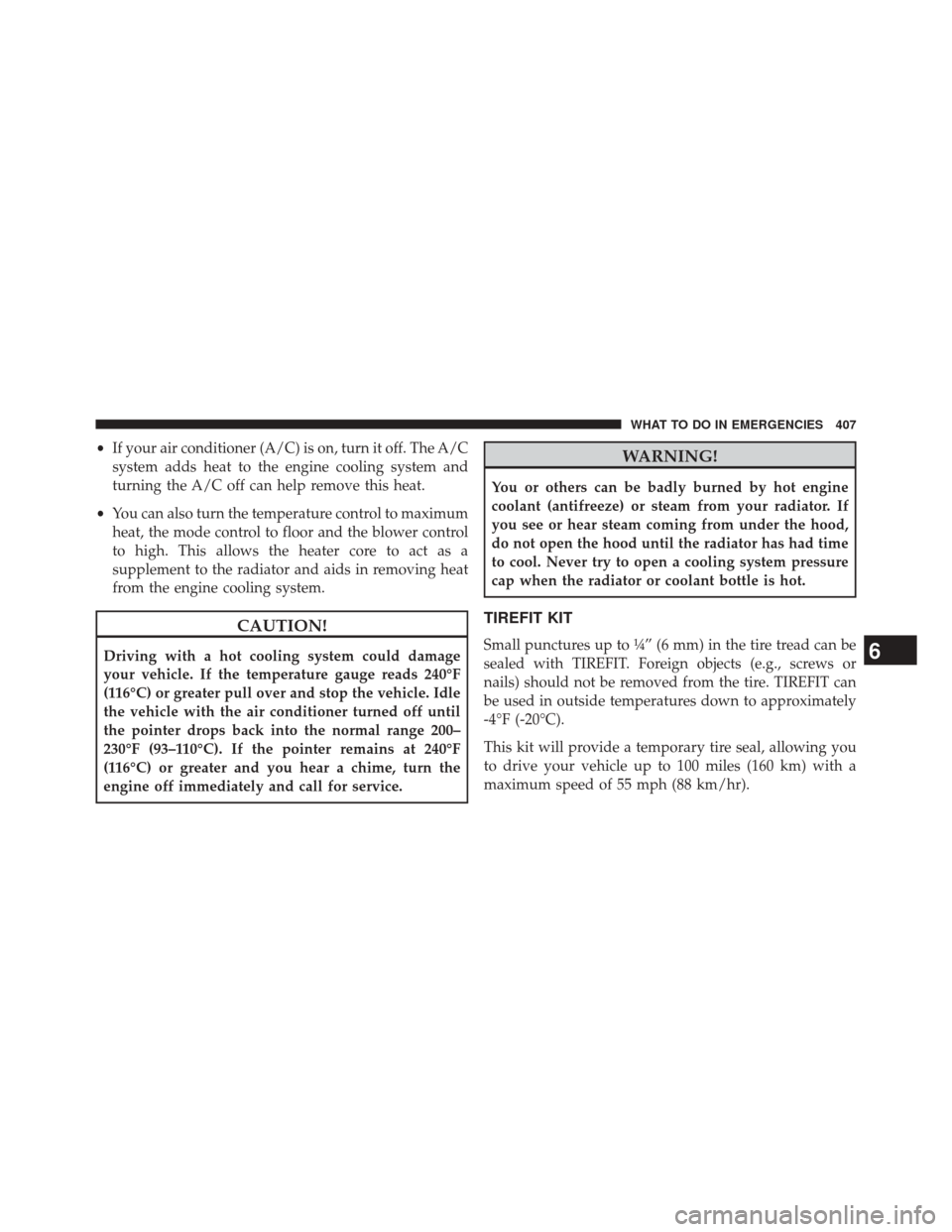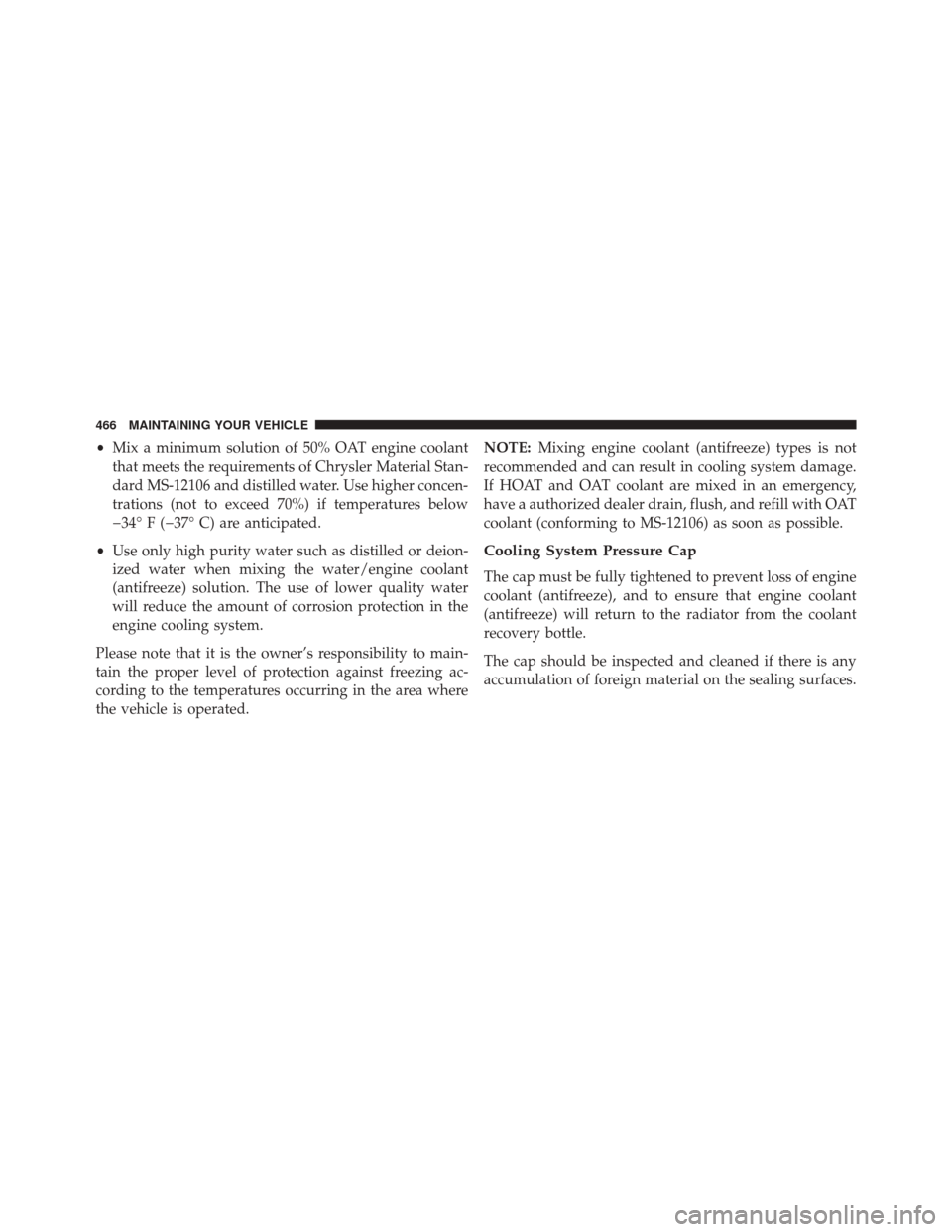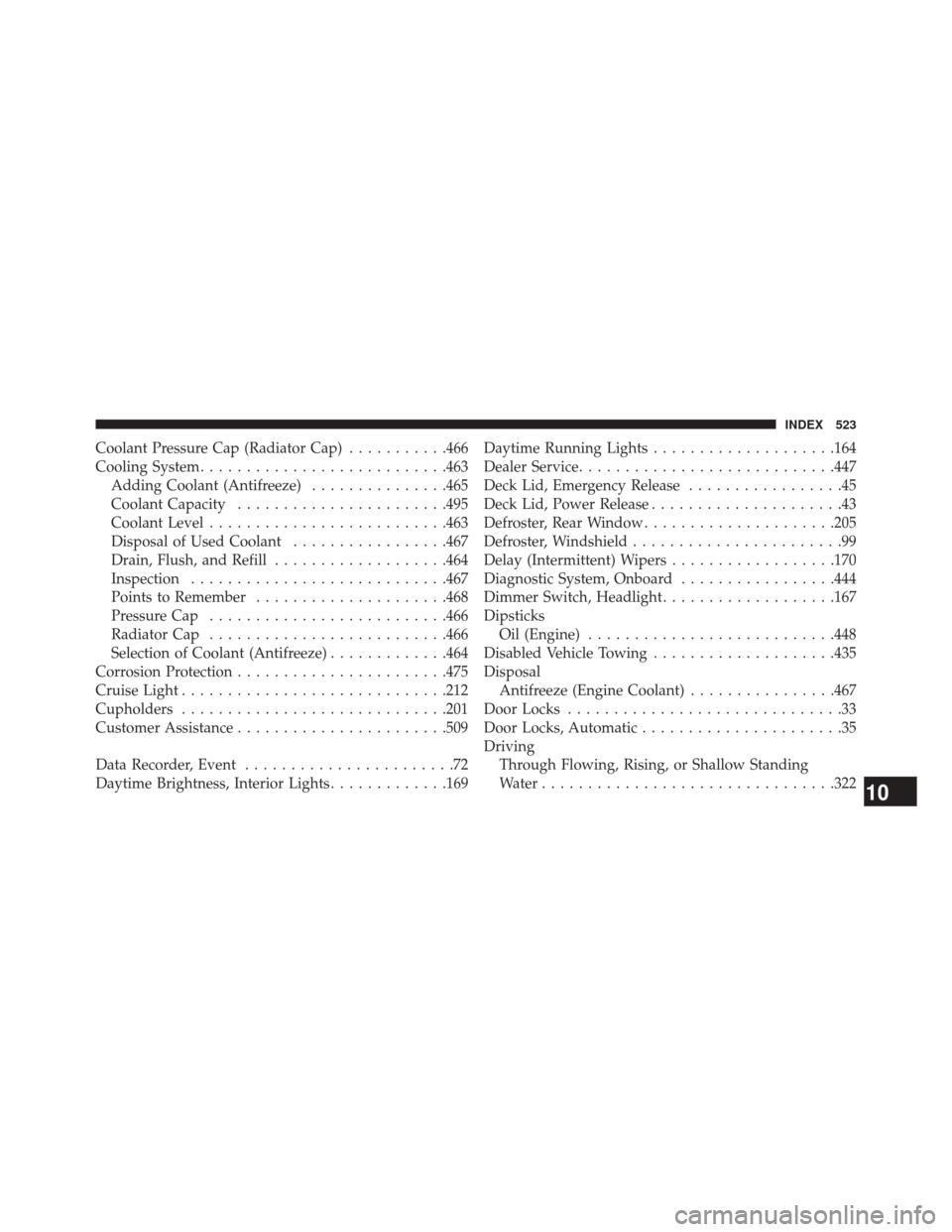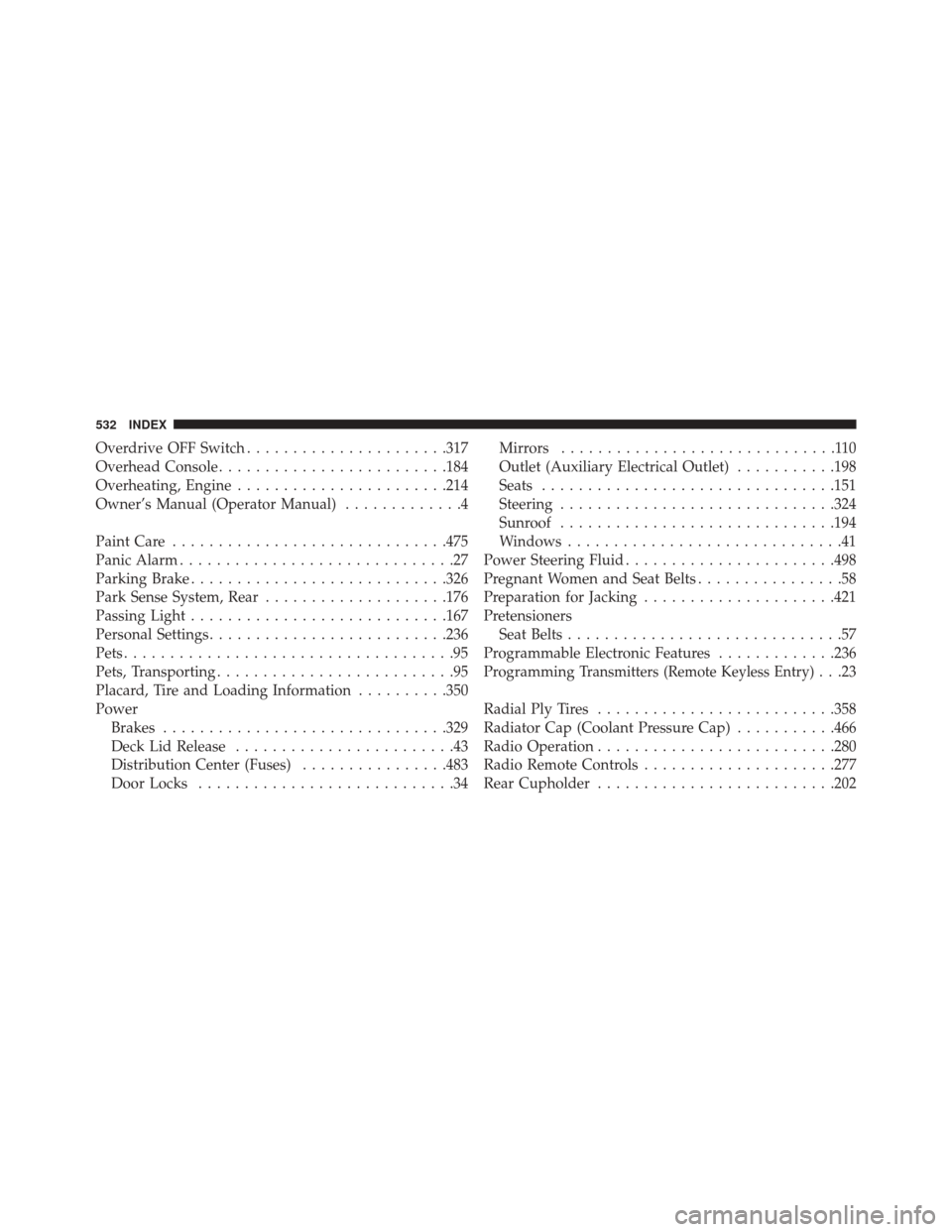2013 DODGE CHALLENGER radiator cap
[x] Cancel search: radiator capPage 409 of 543

•If your air conditioner (A/C) is on, turn it off. The A/C
system adds heat to the engine cooling system and
turning the A/C off can help remove this heat.
• You can also turn the temperature control to maximum
heat, the mode control to floor and the blower control
to high. This allows the heater core to act as a
supplement to the radiator and aids in removing heat
from the engine cooling system.
CAUTION!
Driving with a hot cooling system could damage
your vehicle. If the temperature gauge reads 240°F
(116°C) or greater pull over and stop the vehicle. Idle
the vehicle with the air conditioner turned off until
the pointer drops back into the normal range 200–
230°F (93–110°C). If the pointer remains at 240°F
(116°C) or greater and you hear a chime, turn the
engine off immediately and call for service.
WARNING!
You or others can be badly burned by hot engine
coolant (antifreeze) or steam from your radiator. If
you see or hear steam coming from under the hood,
do not open the hood until the radiator has had time
to cool. Never try to open a cooling system pressure
cap when the radiator or coolant bottle is hot.
TIREFIT KIT
Small punctures up to ¼” (6 mm) in the tire tread can be
sealed with TIREFIT. Foreign objects (e.g., screws or
nails) should not be removed from the tire. TIREFIT can
be used in outside temperatures down to approximately
-4°F (-20°C).
This kit will provide a temporary tire seal, allowing you
to drive your vehicle up to 100 miles (160 km) with a
maximum speed of 55 mph (88 km/hr).6
WHAT TO DO IN EMERGENCIES 407
Page 465 of 543

Cooling System
WARNING!
•When working near the radiator cooling fan, dis-
connect the fan motor lead or turn the ignition
switch to the LOCK position (OFF position for
Keyless Enter-N-Go™). The fan is temperature
controlled and can start at any time the ignition
switch is in the ON position (RUN position for
Keyless Enter-N-Go™).
• You or others can be badly burned by hot engine
coolant (antifreeze) or steam from your radiator. If
you see or hear steam coming from under the hood,
do not open the hood until the radiator has had
time to cool. Never try to open a cooling system
pressure cap when the radiator is hot.
Coolant Checks
Check engine coolant (antifreeze) protection every 12
months (before the onset of freezing weather, where
applicable). If coolant is dirty or rusty in appearance, the
system should be drained, flushed, and refilled with
fresh coolant. Check the front of the radiator for any
accumulation of bugs, leaves, etc. If dirty, clean by gently
spraying water from a garden hose vertically down the
face of the condenser.
Check the coolant recovery bottle tubing for brittle rub-
ber, cracking, tears, cuts, and tightness of the connection
at the bottle and radiator. Inspect the entire system for
leaks.
With the engine at normal operating temperature (but
not running), check the cooling system pressure cap for
proper vacuum sealing by draining a small amount of
coolant from the radiator drain cock. If the cap is sealing
properly, the engine coolant (antifreeze) will begin to
7
MAINTAINING YOUR VEHICLE 463
Page 468 of 543

•Mix a minimum solution of 50% OAT engine coolant
that meets the requirements of Chrysler Material Stan-
dard MS-12106 and distilled water. Use higher concen-
trations (not to exceed 70%) if temperatures below
�34° F (�37° C) are anticipated.
• Use only high purity water such as distilled or deion-
ized water when mixing the water/engine coolant
(antifreeze) solution. The use of lower quality water
will reduce the amount of corrosion protection in the
engine cooling system.
Please note that it is the owner’s responsibility to main-
tain the proper level of protection against freezing ac-
cording to the temperatures occurring in the area where
the vehicle is operated. NOTE:
Mixing engine coolant (antifreeze) types is not
recommended and can result in cooling system damage.
If HOAT and OAT coolant are mixed in an emergency,
have a authorized dealer drain, flush, and refill with OAT
coolant (conforming to MS-12106) as soon as possible.
Cooling System Pressure Cap
The cap must be fully tightened to prevent loss of engine
coolant (antifreeze), and to ensure that engine coolant
(antifreeze) will return to the radiator from the coolant
recovery bottle.
The cap should be inspected and cleaned if there is any
accumulation of foreign material on the sealing surfaces.
466 MAINTAINING YOUR VEHICLE
Page 469 of 543

WARNING!
•The warning words “DO NOT OPEN HOT” on the
cooling system pressure cap are a safety precaution.
Never add engine coolant (antifreeze) when the
engine is overheated. Do not loosen or remove the
cap to cool an overheated engine. Heat causes
pressure to build up in the cooling system. To
prevent scalding or injury, do not remove the
pressure cap while the system is hot or under
pressure.
• Do not use a pressure cap other than the one
specified for your vehicle. Personal injury or en-
gine damage may result.
Disposal Of Used Engine Coolant
Used ethylene glycol-based engine coolant (antifreeze) is
a regulated substance requiring proper disposal. Check
with your local authorities to determine the disposal rules for your community. To prevent ingestion by ani-
mals or children, do not store ethylene glycol-based
engine coolant in open containers or allow it to remain in
puddles on the ground. If ingested by a child or pet, seek
emergency assistance immediately. Clean up any ground
spills immediately.
Coolant Level
The coolant bottle provides a quick visual method for
determining that the engine coolant (antifreeze) level is
adequate. With the engine OFF and cold, the level of the
engine coolant (antifreeze) in the bottle should be be-
tween the ranges indicated on the bottle.
The radiator normally remains completely full, so there is
no need to remove the radiator cap unless checking for
engine coolant (antifreeze) freeze point or replacing en-
gine coolant (antifreeze). Advise your service attendant
7
MAINTAINING YOUR VEHICLE 467
Page 471 of 543

•Make sure that the coolant expansion bottle overflow
hoses are not kinked or obstructed.
• Keep the front of the radiator clean. If your vehicle is
equipped with air conditioning, keep the front of the
condenser clean.
• Do not change the thermostat for Summer or Winter
operation. If replacement is ever necessary, install
ONLY the correct type thermostat. Other designs may
result in unsatisfactory engine coolant (antifreeze)
performance, poor gas mileage, and increased emis-
sions.
Brake System
In order to assure brake system performance, all brake
system components should be inspected periodically.
Refer to the “Maintenance Schedule” for the proper
maintenance intervals.
WARNING!
Riding the brakes can lead to brake failure and
possibly a collision. Driving with your foot resting or
riding on the brake pedal can result in abnormally
high brake temperatures, excessive lining wear, and
possible brake damage. You would not have your full
braking capacity in an emergency.
Master Cylinder – Brake Fluid Level Check
Check the fluid level in the master cylinder immediately
if the brake system warning light indicates system fail-
ure.
Check the fluid level in the master cylinder when per-
forming underhood services.
Clean the top of the master cylinder area before removing
the cap. Add fluid to bring the level up to the “MAX”
mark on the side of the master cylinder reservoir.
7
MAINTAINING YOUR VEHICLE 469
Page 524 of 543

Caps, FillerFuel ................................ .383
Oil (Engine) .......................... .451
Radiator (Coolant Pressure) ................466
Carbon Monoxide Warning ...................97
Cargo (Vehicle Loading) ....................386
Car Washes ............................ .476
Cellular Phone .......................... .280
Center High Mounted Stop Light ..............494
Certification Label ........................ .386
Chains, Tire ............................ .366
Changing A Flat Tire ...................... .418
Chart, Tire Sizing ........................ .344
Check
Engine Light (Malfunction Indicator Light). . .445
Checking Your Vehicle For Safety ...............97
Checks, Safety ............................97
Child Restraint ............................74
Clean Air Gasoline ....................... .380Cleaning
Wheels .............................. .477
Climate Control ......................... .280
Clock ................................. .243
Cold Weather Operation ....................300
Compact Disc (CD) Maintenance ..............279
Compact Spare Tire ....................... .361
Compass .............................. .233
Compass Calibration ...................... .234
Compass Variance ........................ .234
Computer, Trip/Travel ..................... .229
Connector UCI................................ .268
Universal Consumer Interface (UCI) ..........268
Conserving Fuel ......................... .229
Console ............................... .203
Console, Floor .......................... .203
Console, Overhead ....................... .184
Contract, Service ......................... .512
522 INDEX
Page 525 of 543

Coolant Pressure Cap (Radiator Cap)...........466
Cooling System .......................... .463
Adding Coolant (Antifreeze) ...............465
Coolant Capacity ...................... .495
Coolant Level ......................... .463
Disposal of Used Coolant .................467
Drain, Flush, and Refill ...................464
Inspection ........................... .467
Points to Remember .....................468
Pressure Cap ......................... .466
Radiator Cap ......................... .466
Selection of Coolant (Antifreeze) .............464
Corrosion Protection ...................... .475
Cruise Light ............................ .212
Cupholders ............................ .201
Customer Assistance ...................... .509
Data Recorder, Event .......................72
Daytime Brightness, Interior Lights .............169Daytime Running Lights
....................164
Dealer Service ........................... .447
Deck Lid, Emergency Release .................45
Deck Lid, Power Release .....................43
Defroster, Rear Window .....................205
Defroster, Windshield .......................99
Delay (Intermittent) Wipers ..................170
Diagnostic System, Onboard .................444
Dimmer Switch, Headlight ...................167
Dipsticks Oil (Engine) .......................... .448
Disabled Vehicle Towing ....................435
Disposal Antifreeze (Engine Coolant) ................467
Door Locks ..............................33
Door Locks, Automatic ......................35
Driving Through Flowing, Rising, or Shallow Standing
Water ............................... .322
10
INDEX 523
Page 534 of 543

Overdrive OFF Switch..................... .317
Overhead Console ........................ .184
Overheating, Engine ...................... .214
Owner’s Manual (Operator Manual) .............4
Paint Care ............................. .475
Panic Alarm ..............................27
Parking Brake ........................... .326
Park Sense System, Rear ....................176
Passing Light ........................... .167
Personal Settings ......................... .236
Pets ....................................95
Pets, Transporting ..........................95
Placard, Tire and Loading Information ..........350
Power Brakes .............................. .329
Deck Lid Release ........................43
Distribution Center (Fuses) ................483
Door Locks ............................34 Mirrors
..............................110
Outlet (Auxiliary Electrical Outlet) ...........198
Seats ............................... .151
Steering ............................. .324
Sunroof ............................. .194
Windows ..............................41
Power Steering Fluid ...................... .498
Pregnant Women and Seat Belts ................58
Preparation for Jacking .....................421
Pretensioners Seat Belts ..............................57
Programmable Electronic Features .............236
Programming
Transmitters (Remote Keyless Entry). . .23
Radial Ply Tires ......................... .358
Radiator Cap (Coolant Pressure Cap) ...........466
Radio Operation ......................... .280
Radio Remote Controls .....................277
Rear Cupholder ......................... .202
532 INDEX